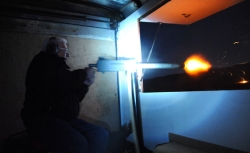Fire in the Hole!
Machine guns, cannons, drones, exploding fish monsters, and a surprising cast of characters at Arizona’s Big Sandy Shoot.
Kenton Tucker has shot machine guns most of his life. He owns several, including, he says, Errol Flynn's machine gun. Tucker, a tidy, middle-aged man with a red mustache, is a principal in MG Shooters LLC, which twice a year sponsors a machine gun shoot at its secluded range in the Arizona high desert. The Big Sandy Shoot is billed as the largest in the United States. It has an unusually wide firing range that stretches for a quarter-mile; about 200 machine gunners can fire their weapons simultaneously at exploding targets and drones. During the three-day event, about 3 million rounds of ammunition are expended.
This vast arsenal of machine guns—and their owners—are tightly regulated. Machine guns have long been among the nation's most regulated firearms. Non-military or non-law-enforcement civilians, like the guys at the Big Sandy Shoot, are required to undergo strict background checks before the federal government allows them to buy a machine gun.
Background checks were the cornerstone of gun control legislation that failed to pass in the Senate this year. Gun control advocates had hoped the measure had sufficient momentum to pass in the wake of Adam Lanza's slaughter of 20 children and six adults at Sandy Hook Elementary School in December 2012. But it didn't, thanks to lobbying by gun industry groups. A recent Pew report says most Americans don't think gun control legislation will pass this year.
As gun control debates wax and wane, and despite the fact that machine guns are already subjected to some of the strictest gun control measures advocates could hope for, there's been little scrutiny of the machine gun community to see just how well gun control works—or doesn't—in America.
The Big Sandy Shoot attracts hundreds of people who chafe at gun control yet seem inordinately proud that they have passed background checks that allow them to own machine guns. They're mostly old white guys, and they're mostly Republicans, and they hate to admit they're Exhibit A for the efficacy of gun control.
Machine guns are true assault weapons; they are fully automatic, meaning that one pull of the trigger fires more than one round. (Semi-automatic guns, like the ones used in many mass shootings in the United States, are not true assault weapons because they require one pull of the trigger for each round.) In the United States, machine guns have been highly regulated since passage the National Firearms Act of 1934, and a series of laws that followed tightened restrictions on machine gun owners. While most Americans can legally buy guns without background checks via private sales and gun shows, machine gun purchasers wait for months as their background checks are being processed by the feds. And while most Americans can buy modern non-assault weapons easily, machine gun owners aren't allowed to own any machine gun manufactured after 1986. In a nutshell, unlike many gun sales in the United States, machine gun sales are carefully tracked and taxed by federal authorities.
Tucker is wary of journalists, whom the machine gun world generally views as shills for liberals who want to disarm America. But after meeting with photographer Marie Baronnet and me in Scottsdale, he agrees to let us cover the shoot with no restrictions.
We almost don't make the required shooters meeting on the first day of the shoot because we take our time on the road. From Phoenix the highway winds through salmon-pink sand flats studded with cactuses to Wickenburg, famous for its dude ranches and addiction recovery centers. We cruise past curio stores and horse pastures and catch Highway 93, which knifes into the Arizona badlands. The mountains are jagged and parched.
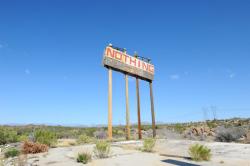
Photo by Marie Baronnet
At Milepost 148, tourists snap pictures of Nothing, Ariz., a cluster of boarded-up, sun-chewed shacks that once housed an All Mart and a gas station. A warning is scrawled in black spray paint: “No Trespassing. Private Property. Keep Out.”
West of Nothing we pass a biker bar, a barbecue joint, a trailer park and a log furniture store, which pretty much sums up the commercial center of downtown Wikieup, population 133. We're well into Mohave County now, and it feels like militia country. Oklahoma City bomber Timothy McVeigh hung out with his friend and terrorism accomplice Michael Fortier in Mohave County. Jason Bush, the border vigilante condemned to die for slaughtering a 9-year-old girl and her father during a bloody home invasion, was arrested in Mohave County. About 202,000 people live in the county, which sprawls over 13,470 square miles. It's a good place be a hermit or play war games.
We veer right onto Trout Creek Road, follow the arrow on the white poster board sign that reads "Big Sandy Shoot." Five miles of dusty, up-down, windy dirt road later, we descend into a valley where spectators are allowed to camp and have tailgate parties.
We register at a folding table, then drive a rutted road leading up a steep, rocky bluff to the fabled Big Sandy Range. Camouflage nets separate dozens of shooting stations. Most are equipped with folding tables and chairs, tools, ice chests, metal ammo cans, wooden ammo boxes, and machine guns on tripods.
The machine guns face the target area, a wide, dry wash. Dozens of white barrels—the targets—line the wash. The target area is "backstopped" first by its own eroded bank, and then a cratered hill, and then a mountain. The layers keep rogue rounds from escaping and killing a cow or coyote. Yellow police tape flaps in the wind, marking the boundary between the target area and shooting stations. The shooters have set up campsites a few feet behind their machine guns. Some will sleep in RVs, others in large trucks and tents.
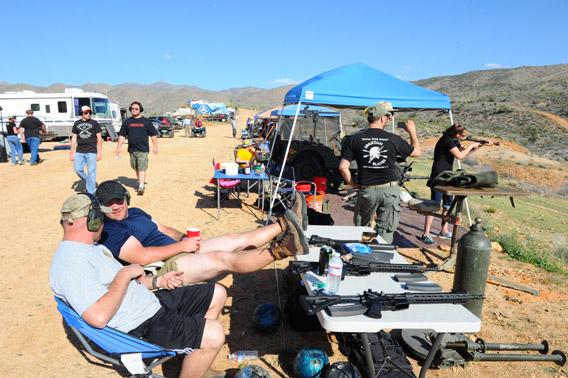
Photo by Marie Baronnet
The shooters are mostly middle-aged or older white men dressed in camouflage or hunting gear, baseball caps, and dark glasses. They are gathered around Tucker, who gives last-minute safety instructions.
When he finishes, the shooters hurry to their stations.
A signal horn blares.
A red flag shoots up a pole.
Someone yells: "Fire in the hole!"
The machine gunners start shooting, and yellow smoke sours the air. I've got my black-and-yellow ear protectors on but still hear the cacophony of tat-tat-tat-tat-tat-tic-tic-tic-tch-tch-tch-tch-tch-pop-pop-pop-pop-pop of the smaller machine guns interspersed with a nerve-rattling thunderous kettledrum-on-steroids sequence BAM-BAM-BAM-BAM. It's the sound of .50-caliber machine guns, designed to flatten armored vehicles and low-flying aircraft.
I try not to wince as I adjust my loop earrings under the ear protectors and consider the journalistic challenges ahead. I want to know how real gun control works. Who are these shooters who pass the rigorous background checks? Will they open up to me? Are they especially thin-skinned in the wake of the tragic shootings at Sandy Hook? It's late March. Arizona is in the middle of the fray: Recently retired Rep. Gabrielle Giffords, who was shot through the head by a gunman near a Tucson-area Safeway store in 2011, and her astronaut husband, Mark Kelly, are campaigning for gun control legislation. Even Arizona Sen. Jeff Flake seems to be leaning toward the proposed legislation.
Machine guns are already tightly regulated, but will these shooters chafe at regulation of their other guns? Looking down the firing line, I see other guns that aren’t as restricted: semi-automatic pistols and rifles. There's also a cannon.
A cannon isn't technically a machine gun, since it fires one round at a time. But shooters can shoot anything at the Big Sandy Shoot, including homemade bowling ball launchers.
I join several ear-protected onlookers staring at the cannon. Someone says it was built in 1942. We're careful not to stand directly behind, in case it backfires.
The cannon guy is oblivious to the attention. He's a graceful, slender man with a cryptic smile. He looks to be in his 40s and wears a Panama hat, an immaculate sports shirt and tailored slacks, as though he'll soon be heading off to a golf game at the club. He's in a cannon-firing Zen trance, mechanically loading and shooting, loading and shooting, loading and shooting. Later, I ask him his name. He won't give it. He doesn't want to be photographed. He looks rich.
But then again, there must be a lot of rich people here. Machine guns sell for tens of thousands of dollars, thanks to Ronald Reagan. In 1986 the Republican president signed the Firearms Owners' Protection Act, which prohibited the general public from owning, buying, or selling machine guns manufactured after the 1986 law took effect. Broadly, the law says military and law enforcement officials can still own machine guns, but civilians can only own machine guns that were grandfathered in.
"Machine guns available to the public are a finite resource," Jose Wall, a special agent for the Bureau of Alcohol, Tobacco, Firearms and Explosives in Phoenix, told me before I left for the shoot. "So what's in circulation back then [1986] is in circulation now." And that's a little less than 100,000 machine guns, Wall told me.
All of this explains why from the get-go the machine guns at the Big Sandy Shoot seem always to be giving the shooters trouble. Something about the way the shooters use wrenches and rubber hammers to coax the guns to shoot again reminds me of taxistas tinkering with ancient Fords in Havana.
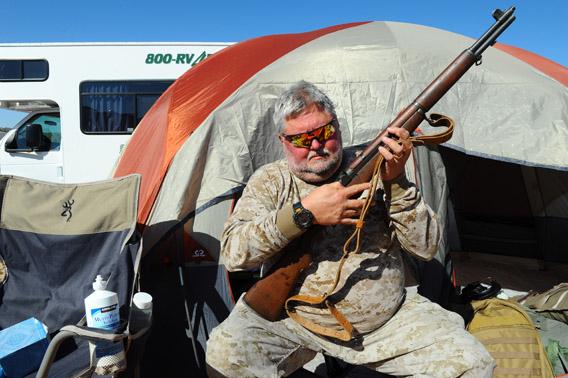
Photo by Marie Baronnet
Kenton Tucker's business partner in MG Shooters LLC is Ed Hope. He's a 71-year-old retired high school teacher who owns about 30 machine guns. He's a Democrat who voted for Barack Obama and a member of the National Rifle Association.
Hope sits in his quad, smiling, taking a break from driving up and down the range to monitor shooters. This shoot is just so much fun, he says. He asks if I've seen "the fish." I have. It's a hollow Volkswagen Beetle-size black-and-white shark-type monster. It has nasty eyes, four upper teeth, and a long, red tongue that licks the ground. When the range is "cold" and no one is allowed to shoot, the fish monster will be loaded with explosives and towed to the target area, where the shooters will blow it up.
Hope and Tucker have been putting on shoots for 25 years, and they know gun guys like to shoot "reactive" targets, meaning targets that explode when you shoot them. Hope and Tucker bought the Big Sandy property, which spans 1 square mile, about 10 years ago, because it is so remote that you can safely shoot and explode as many targets as you want. So far no one has been injured, Hope says. The Big Sandy shoots are a "full-time job" for Tucker and Hope, who won't disclose earnings derived from the shoot. For Big Sandy shoots, they hire 30 people to help monitor the range, direct traffic, and sell tickets. In three days about 600 spectators will pay $25 to watch about 200 shooters, who pay $250 to shoot.
"Most of my shooters are upper-income professionals," Hope says. The monster .50-caliber Browning can cost $25,000, for instance, and all the government regulation is "an incredible pain." It might take six or seven months to complete a machine gun sale, called a "transfer." What's more, Hope says, machine guns are "hungry and you have to feed them ammo."
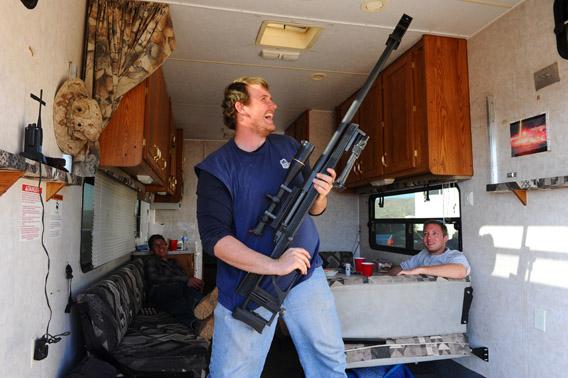
Photo by Marie Baronnet
Eric Lutfy is at the Big Sandy Shoot to sell ammunition. He has been in the "gun business" since he was 18. He lives in Laveen, Ariz., and is the president of Thunderbird Cartridge Co. Inc., a purveyor of reloading components and reloaded ammunition. Ammo is stored in neatly labeled boxes beneath a folding table behind the shooter stations. A whiteboard lists his prices: A count of 150 tracer .50-caliber rounds sells for $300, for instance.
Reloaded ammunition is basically recycled and rebuilt ammunition. After you shoot a gun, the spent casing will fall to the ground near you. If you happen to own a reloading machine, you can prime and resize the used casing, fill it with gunpowder, and cap it with a new projectile. It's tedious, hard work, but if you shoot a lot, it's cheaper than buying new ammunition.
Ammunition costs are skyrocketing, due in part to nationwide hoarding, which inflates the price of ammunition, which causes more ammo hoarding. Michael Bazinet, a spokesman for the National Shooting Sports Association, an industry group, says ammunition manufacturers now "work round the clock" to fill consumer demand. For 34 straight months, he says, gun sales have gone up, and so have attendant ammunition sales. In 2012 combined retail sales for guns and ammo totaled $6 billion.
Gun control proponents suggest the gun industry is driving a profitable panic. They say the industry is needlessly frightening gun owners into thinking their guns and ammo will be taken from them via gun control legislation. Bazinet says it's not true. Consumer demand simply exceeds manufacturing capability, he says. He agrees, though, that if people think "access might be limited," they will buy more ammo and guns.
John Watson and his friends have brought 5,000 rounds of ammo to the Big Sandy Shoot. They've reloaded some of the ammo at home during "loading bees." Watson, a 69-year-old retired fire marshal and Vietnam vet who lives in the Phoenix area, also brings along a mannequin named Mary Lou.
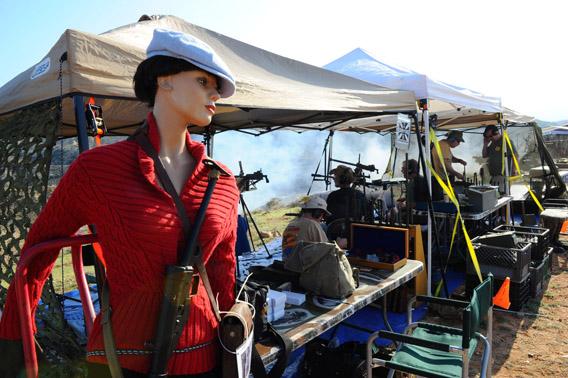
Photo by Marie Baronnet
The mannequin is dressed like a French Resistance fighter and stands by the shooting station Watson shares with his friends. He got the mannequin from his wife's consignment store and has been bringing her to the shoot for several years, dressing her each year in a different military uniform. Mary Lou is a fixture at the shoot, along with Watson's plastic pink flamingoes and his 1958 Airstream.
To Watson, the Big Sandy Shoot is "Super Bowl, Nascar, and the World Series all wrapped into one." He has been attending the shoots since 2006, and he's recruited friends who share a shooting station, which has a blue-tarp floor covered with spent casings. Their machine guns rest on tripods. Shawn Rhodes, a former paramedic, and Bill Rhodes, a software engineer, both wear beige MG Shooters T-shirts. Another friend, David Stevens, a theater technician (he's a got tattoo that reads “AITA,” which stands for “Acceptance Is The Answer”), brought along two semi-automatic rifles that resemble AK-47s.
As we talk, a mini-machine gun, said to cost about $100,000, shoots off thousands of rounds a minute. As the gun fires away in the distance … rrrrrrrrrrrrrrrrrrrrrrrrrrrrrrrrrrrrr … the men joke about how shooting a mini-machine gun costs as much as a mortgage payment … rrrrrrrrrrrrrrrrrrrrrrrrrrrrrrrrrrrrr.
The only food concession at the shoot is the 4-H cook tent, overseen by Linda Olson, who lives in Kingman, some 40 miles west of the range. Her long blond hair is pulled into a ponytail and she wears sunglasses, a baseball cap, jeans, and a T-shirt that reads, “25 years ago we had Ronald Reagan, Johnny Cash and Bob Hope. Now we have Obama, no cash and no hope.”
Olson is 56, an obstetrical nurse at the local hospital, and she is worried about the country because Americans "should be headed towards self-sufficiency, and what I see is people moving the other way."
Members of the 4-H club aim for self-sufficiency by selling pulled pork, spaghetti, potato chips, Cokes, hot dogs, and burgers. During lulls between meals, the 4-H-ers sit on ice chests, seemingly oblivious to the shooting. Most of them are teenagers who think machine guns are cool, except for one girl who wants to be a biologist.
I've been scanning the skies all day for massive black drones. During our first meeting, Kenton Tucker emphasized that shooting drones has long been a highlight of the Big Sandy Shoot. I square this with my image of conservative gun owners who must view drones as intrusive technology, Obama's killing machines, or both. Perhaps they're shooting drones, I think to myself, to prepare for the inevitable American Armageddon, in which the government fights its own citizen-patriots. I soon realize I've mischaracterized the drones. The Big Sandy drones are small corrugated plastic airplanes. In the Arizona sky, they look like flying white triangles. They have tiny motors and propellers. They're toys.
Kevin Davis, the drone guy, is a slender, quiet 50-year-old military helicopter builder from the Phoenix area. He tinkers with motors, gets the things to work. When he's ready to launch a drone, a range safety officer yells, "Bird in the air!"
The tiny motor whines like an insect. Davis fingers the remote control, making the flying target flip, dip, soar, and dive the length of the target area. All the guns begin shooting at it, and they make a lot of noise, but they miss.
"Wind's gnarly," says Davis.
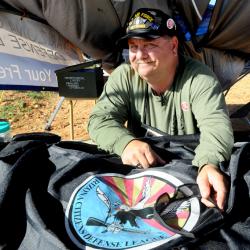
Marie Baronnet
In the vendor area, Mark Spencer mans the Arizona Citizens Defense League booth. The group has lobbied, successfully, for Arizona's lax gun laws. You can carry a gun into a bar in Arizona, for instance. You can pack a concealed weapon without getting permission from authorities or taking a test.
This contrasts with the machine gun laws, which remain ironclad. Spencer would like to see them relaxed.
Spencer is an "IT guy for the government," and he lives in Sierra Vista, Ariz., the home of the Army's Fort Huachuca. He's a heavyset man with sad blue eyes. He says he wishes he hadn't quit the Air Force in 1982. That was a mistake, he says, and his dad never let him forget it. He and his father had little in common except for shooting. Spencer enjoyed acting in plays, but his dad never came to watch them, so Spencer played football instead.
At the Big Sandy Shoot, Spencer gives away bumper stickers that read, “Liberty is not a loophole.” He tells people that if a store or restaurant won't let them pack a gun on the premises, they should launch a silent protest by walking in with an empty holster.
***
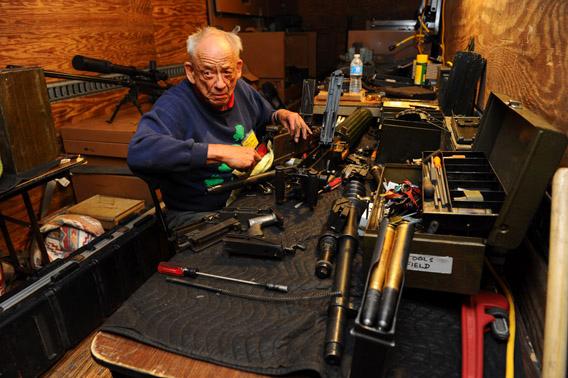
Photo by Marie Baronnet
At night, red and green tracer rounds arc into the sky, and flares cast an eerie strobelike light on the exuberant shooters still at their stations.
Behind the shooter stations, in a truck trailer bed that's been converted into a gunsmith shop, Dolf Goldsmith tinkers with a 1918 machine gun. He's a stooped, balding guy in his 80s who is recovering from recent heart surgery. He's wearing a frog-print shirt because he loves frogs almost as much as he loves machine guns.
He grew up in the Netherlands and moved to the United States when he was 16. He served in the Korean War. His father wanted him to go to college, but he didn't finish. Instead, he became a machine gun expert. He's owned about 1,000 machine guns, and he's written several books about machine guns. He invented a special screwdriver to repair machine guns.
The night sky is red, the air acid. The .50-caliber guns thunder away. Spectators in shooting glasses, hoodies, and ear protectors run past Goldsmith taking iPhone pictures. Goldsmith ignores the theatrics. He's got a 95-year-old machine gun on the table in front of him, and he's got to figure out how to coax it into shooting once again.
I have breakfast at the Hampton Inn in Kingman with Darwin Edwards, 66, an atheist, a world traveler, and a retired pathologist who lives in Kentucky. He admires Hunter S. Thompson and G. Gordon Liddy for their courage and fearless individualism. He says his greatest challenge is fitting into the Louisville social scene, where guys talk mostly about football or basketball, which bore him.
Edwards shoots in jeans and a plaid shirt instead of camouflage. He has no interest in any guns except for machine guns. He likens regular guns to pot and machine guns to crack cocaine.
A few days before the Big Sandy Shoot, he packed his toolbox, ammo, an ice chest, and three machine guns (a Vickers World War I machine gun, a Browning World War II anti-aircraft machine gun, and a Vietnam-era M-60 machine gun) into his wife's white Mercedes-Benz SUV and drove to Arizona with his friend John Paskey, a soft-spoken retired chemical engineer who works in the photo department of his local Walmart. (Paskey brought along his .50-caliber bolt-action rifle.)
Like most Americans, Edwards favors universal background checks because, he says, background checks would help keep guns out of the hands of "criminals and mentally ill people."
"I wanna be honest with you," Edwards says, "a lot of gun owners are not well-educated and not terribly bright."
He pegs many of his fellow shooters as "ultraconservative guys" who "don't think things through." Edwards says most gun owners are "100 percent against the Obama presidency" and "automatic Tea Party people."
Paskey, Edwards' traveling companion, is a Tea Party person, because he's concerned about government spending and the national debt. Still, Edwards treasures Paskey's friendship because the two have interesting conversations about science and guns and history.
The two men invite me to visit them at their shooting station, and Edwards offers to let me to shoot his machine gun, a belt-fed Browning ANM2. During World War II it was a rear-facing aircraft gun, and he says it's so much fun to shoot.
I'm game.
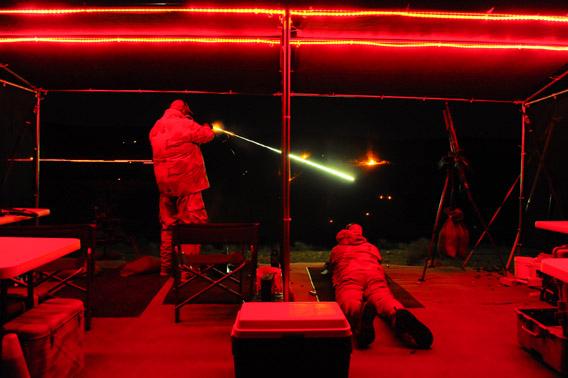
Photo by Marie Baronnet
As a child I lived on an Arizona ranch with my parents, cowboys, horses, cattle, mountain lions, rattlesnakes, and guns. I wasn't allowed to touch my mother's pistol, which she kept on the top row of the bookshelf (she stored the ammo in her lingerie drawer), or my father's shotgun, ensconced on the top shelf of his closet, near the Christmas decorations. My father and the cowboys used their guns to euthanize suffering domestic animals, or to kill the rare wild animal that posed an imminent threat, or to hunt game, or for self-defense.
Like 43 percent of Americans, I have a gun in my home. I know how to shoot my pistol. But this is the first time I've ever shot a machine gun.
I sit on an empty wooden box that once held Winchester ammunition manufactured in Portugal. I sight the Browning, which shines in the sun and is anchored on a tripod. With the sight fixed on a white barrel in the wash, I pull the trigger: pop pop pop pop pop pop ... pillows of buff-tinted dust billow around the white barrel.
I'm much too frugal to shoot machine guns.
Mindful of ammo costs, I stop. Edwards wants me to shoot the entire belt, about 250 rounds. I do.
Edwards laughs. He's so happy.
"Are you hooked yet?" he asks.
I'm not, but I'm grateful for his generosity.
***
The wind has picked up considerably, and Charles Swan's white lab coat looks like an unfurling sail. Swan shoots guns in a lab coat because, like his floppy sun hat, the lab coat protects him from harmful UV rays.
Swan is 28, brown-haired and slender. He works for a major Seattle company that he asks I not name. He came to the Big Sandy Shoot for "cultural exploration," he says, because Burning Man was sold out. "This type of shooting is super-old-white-guy shooting," he says. "The guns they are shooting are like from the fucking ’60s or something."
"I came here expecting to see old white guys and I found old white guys, and they're so nice. And usually they have at least two interesting stories to tell, because they've lived so long," he says.
He says one of his objectives is "not to be too disagreeable," so he doesn't say, for instance, that he voted for Obama, although he's become increasingly disenchanted with "all the wars."
He bought his first gun when George W. Bush was president, because Bush began "torturing people" and getting the country into "terrible debt" with "needless expensive wars." Before Bush, he says, he "never thought tyranny could exist in America."
Swan now owns a .50-caliber bolt-action rifle, a water filtration system, and some dried food. But he doesn't view himself as a survivalist.
At lunchtime, when the range is "cold" and there's no shooting, staffers load the fish-monster target sideways on the bed of a cobalt-blue Ram 3500 pickup truck and cart it out to the target area. Its cavernous belly is filled with explosives. It’s scheduled for destruction later in the afternoon.
About 20 RVs and 40 cars park in the spectator area for the Saturday night shoot. Parents bring their kids. One mom lets her son shoot a machine gun. It’s because he has cancer, she explains.
Kenton Tucker has arranged for additional spectators to be helicoptered in from Las Vegas. Visitors can shoot Uzis and AK-47s and M16s at the rental booth on the firing line, but it's expensive: $4 a round to shoot a .50-caliber machine gun.
A French radio crew is covering the shoot, and the audio guy tells me, "For a European, this is something one could not imagine."
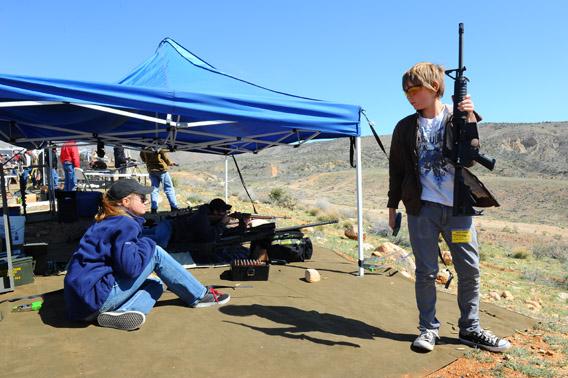
Photo by Marie Baronnet
John Ulicki fits a European’s stereotype of a red-state, gun-loving, proud, brash American. He's a big man, standing 6 feet 4 inches and weighing 245 pounds, a 47-year-old construction-site manager who moved from California to Utah. He says assault weapons have "gotten a needless negative connotation" from liberals and journalists. He sees a great cultural divide between liberals in the coastal areas and "the rest of the country." He would prefer if liberals seeking gun control legislation would "stay out of our culture."
Ulicki believes the gun control debate is dishonest and wrongly maligns gun owners. He doesn't like California Sen. Dianne Feinstein or New York City Mayor Michael Bloomberg, and he doesn't appear to have much use for me or my pesky questions. Journalists can often be "evil-hearted" and do "hit pieces," he tells me before he walks off.
Half an hour or so later, he's sitting near his shooting station, joking with Ed Hope about liberal reporters. He's in a conciliatory mood, and so am I, and we give each other a hug.
Then he suggests I shoot an M16A1 fully automatic military assault rifle.
This is a gun that resembles the guns in video games. The fully automatic version is banned to civilians unless it was legally purchased before the 1986 Firearms Owners’ Protection Act took effect. But there is a similar semi-automatic version that is perfectly legal, the AR-15.
The AR-15 was one of the guns allegedly used by James Holmes to mow down people in a Colorado movie theater.
A group of old white guys gathers behind me as Ulicki loads shiny gold rounds into the M16 magazine. I hand my reporter's notebook to a man behind me and touch the killing machine. It's black and very warm in the sun. It's got an adjustable stock, which Dianne Feinstein has been trying to ban for years.
My message to Dianne Feinstein: Adjustable stocks don't always work.
Adjustable stocks are supposed to make the gun easier to shoot and more comfortable, but in my case adjusting the stock doesn't help at all. The M16 is a powerful military killing machine, and it takes militarylike discipline to learn to shoot it properly. I do not know how to stand, or how to lean forward and cradle the gun when I shoot.
The first time I shoot at the target, Ulicki stands behind me to make sure I don't freak out. The second time, he puts the gun on full auto and steps back. I sight it, awkwardly, and brace myself as best I can, and shoot. I fire a bunch of rounds and hit the target at some point. I'm happy to return it to its owner, a guy who works for a wildlife agency in the South.
When I retrieve my notebook, I see the man who held it for me drew a smiley face and wrote, "Good Job!"
***
By 9 a.m. Sunday, many of the shooters and most of the spectators have packed up their gear and headed home. There's still fire in the hole, and the wind slaps at the flying red flag. With only a few shooters, it's not nearly as loud.
Bits and pieces of the fish monster are scattered in the wash, and I realize I missed seeing it explode.
John Ulicki lingers at his campsite, breakfasting on cheese and eggs. I sit down at his table, having redeemed myself somewhat in his eyes by shooting the M16. He absolutely believes that there is a concerted backdoor effort to disarm Americans, and it's called gun control, and the press in general is sympathetic to gun control.
Newtown deeply saddens him, and he can't imagine the grief the parents feel. But it's wrong, he says, to "take away the rights of one group because of the emotions of others."
Before he packs up, he asks me if I want to shoot a 1940 anti-tank Swiss machine gun.*
Seriously?
This is the diaphragm-rattling, eardrum-splitting machine gun I've avoided all weekend. But after shooting Edwards' funky World War II Browning and the nefarious M16, I figure I can shoot anything.
The Swiss monster is an enormous black gun anchored to a sandbagged tripod. The cartridges are as long as my hand.
To shoot and sight the gun, I have to lie on my belly in the dirt. I sight the cross hairs on what's left of a target barrel after 19 hours of machine gun shooting, and tighten it.
I pull at the massive trigger, but my fingers aren't strong enough to budge it.
I've still got the gun sighted, so Ulicki leans over, put his big hand over mine and pulls the trigger.
The gun roars.
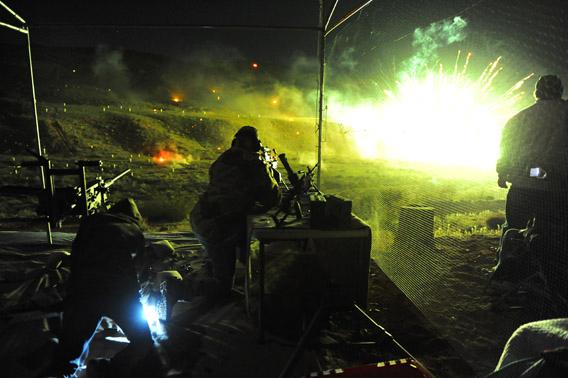
Photo by Marie Baronnet
In the weeks that follow, the Senate slaps down gun control legislation, thanks in part to Jeff Flake, who votes against the measure. Gabby Giffords and Mark Kelly vow to soldier on via their Americans for Responsible Solutions PAC. They don't talk about machine guns.
I ring up Eric Lutfy, the ammunition salesman, who says even though gun control failed, gun owners remain "scared to death" of gun control. "People believe that the Obama administration is forming an army funded by the U.S. government under the pretext of homeland security," he tells me. "That's the word on the street."
Darwin Edwards and his friend John Paskey left the Big Sandy Shoot early. The 4,000-mile round trip from Kentucky, Edwards says, was worth doing once. He says the machine gun community proves the efficacy of rigorous background checks: "Machine gun owners are one of the few groups of people who can prove they're not felons." Ammo remains "really just not available because of the feeding frenzy" fueled by the gun control legislation. But Edwards isn't worried. He's got enough ammo to last him the rest of his life. He's deeply disappointed that the Senate didn't pass gun control. "The majority of people in the country, including me, were in favor of that particular bill," he says. "I don't see how any thinking person would vote against it."
Kenton Tucker and Ed Hope are busy organizing the next shoot, coming up in October. Hope says the spring Big Sandy Shoot was the best ever. Attendance increased, and the remote machine gun range maintained its stellar safety record.
Me, I keep thinking back to shooting that Swiss anti-tank monster machine gun. Man, was that fun.
Marie Baronnet is a French photographer based in Paris and in Los Angeles, who has shot actors and directors on stage, love motels in Brazil, Las Vegas with the lights off, survival in Haiti, the Amazons of Ciudad Juarez, Tornado on war path, Queens of Burlesque. She invites you to see more: mariebaronnet.com.
Correction, Sept. 7 2013: This piece originally misidentified a 1940 anti-tank Swiss machine gun as a .50 caliber machine gun. (Return.)
